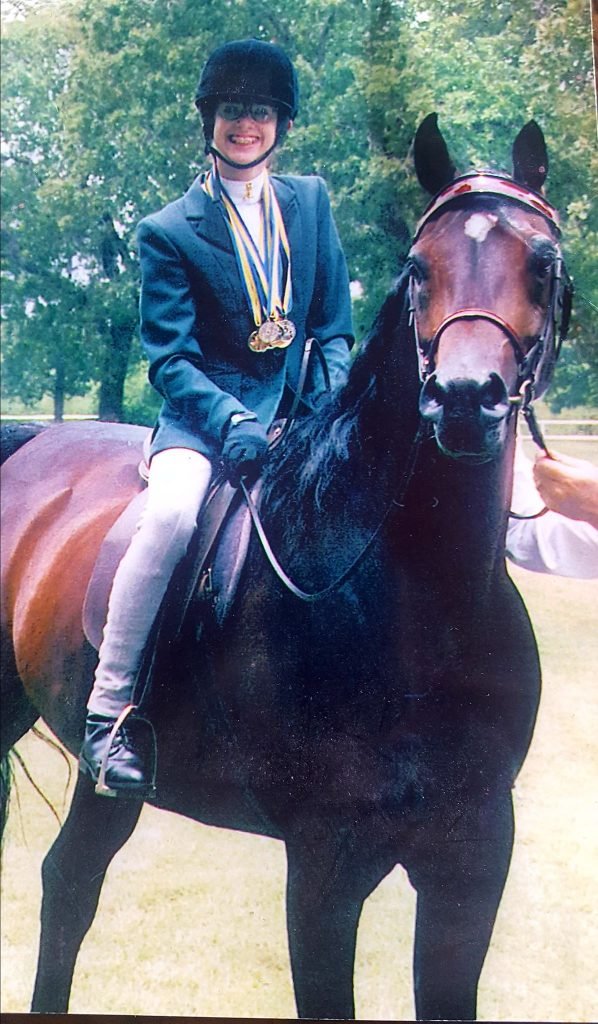Shanda was born with cerebral palsy and epilepsy. Immediately after birth, her doctors had to insert tubes to support her breathing. Her mother, Shannon, said she never heard her baby cry until the tubes came out a month and a half later. Her doctors diagnosed Shanda soon after that so her parents could prepare themselves for life with a disabled child.
Shannon trained, groomed, and exercised racehorses for a living. She took Shanda and her dog to the track barn with her when she was six months old. Shannon carried Shanda on her chest while she rode from the time her baby was six months old. When Shanda was two years old, her mom let her sit in the saddle with the horse at a walk. At three years of age, she put Shanda in an equine therapy program. A year or so later, Shannon began looking for a horse for Shanda. She told me she looked at eight different breeds of horses for her daughter. The last one they looked at was quite a drive from their home. When they arrived to see the horse, Shanda was in a wheelchair. Shannon pushed the chair to the arena rail while the owner brought the horse out of the barn and turned her loose. The Arabian mare, Persiaa, exploded and galloped around the arena with her tail in the air, snorting and blowing as only an Arabian can until she spotted the child in the chair at the edge of the arena. Persiaa turned and galloped straight for Shanda, causing great concern for Shannon. The mare put on the brakes four feet from the rail, walked to the rail, and dropped her head in Shanda’s lap. Shanda held onto Persiaa’s face, and the two breathed in each other’s scent and stared into each other’s eyes for eight minutes ignoring everything and everybody else around them. Shannon and the horse owner watched in amazement. Shannon bought the mare for Shanda right then.
Shanda continued her equine therapy on her beautiful Arabian mare, Persiaa, for several years. It developed her core strength, improved her sense of balance, and improved her self-image. Children with disabilities, similar to Shanda, often think about what they can’t do far too often. When a child can ride a horse and direct a thousand-pound animal, they gain self-confidence and add “can” to their vocabulary. While there are things they physically “can’t do,” they “can” ride a horse! Most of them develop a strong sense of pride in that.
Shanda learned to groom Persiaa on her own. Persiaa stood perfectly still while Shanda brushed her down, head to tail, using a walker or wheelchair for support. Shanda got on the ground and crawled to Persiaa’s feet, one at a time. Persiaa picked up each foot, in turn, so Shanda could clean them out after riding. She used Persiaa’s leg to get herself off the ground and back into her wheelchair or walker when she finished. Persiaa never flinched or moved a muscle until Shanda was in the clear.
Shannon entered Shanda in the Special Olympics Equestrian Events when she was between nine and ten years old. Shanda and Persiaa competed in English, Western, Equitation, Pole Bending, Obstacle Courses, and Balanced Riding events throughout Shanda’s high school years. The pair earned 21 Gold Medals, 20 Silver Medals, and one Bronze Medal in competition.
Shanda decided she wanted to learn how to drive a horse. Her mother cautioned her that it might be difficult for her, but she put her mind to it, and with Persiaa’s help, she learned to drive through gates in the arena by herself. She adapted to her limitations and figured it out by herself.
When Shanda graduated from high school, it was time for graduation pictures. She wanted the photograph taken with Persiaa and her emotional support/service dog, Hot Coco. The photographer came to the home and took the perfect picture. It now hangs in the hallway near the front door of their home.
The vet diagnosed Persiaa with cancer 19 years after she found her home with Shanda. Shannon let Shanda decide whether to continue to treat the mare and have her for another year or end her suffering. Shanda, despite, and perhaps because of their strong bond of love, decided it was best to stop the mare’s pain. It took a couple of years for Shanda to reignite her interest in horses. Losing Persiaa was the most heartbreaking thing she’d been through.
Today, Shanda has a new horse to love and care for. She found Burlesque and continues her riding on another Egyptian bred Arabian horse. Shanda hopes to compete at rated Arabian Shows in Driving competition in a couple of years. I know, from Shannon’s description of Shanda’s determination, that Shanda will be showing in the arena within the timeframe she set for herself. I hope I get a chance to see them. I wish Shanda and Burlesque much success.


